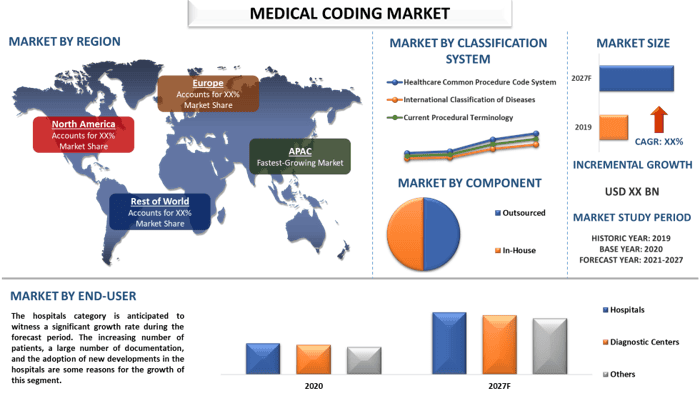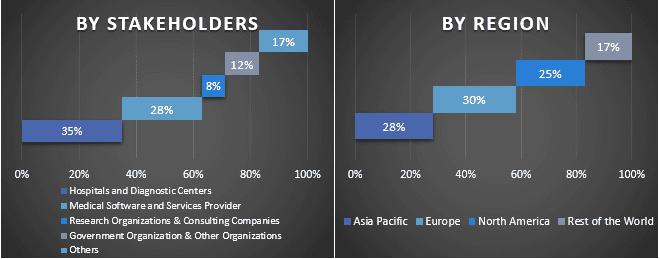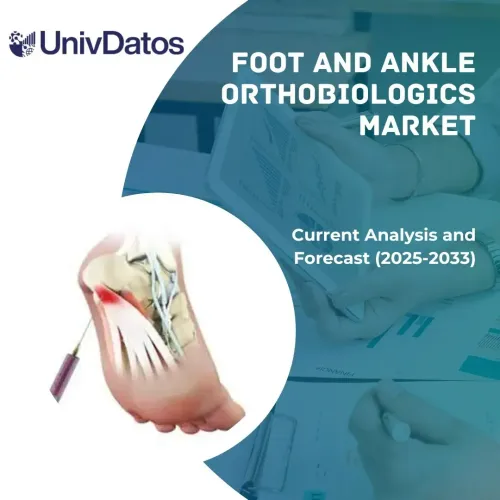- Strona główna
- O nas
- Branża
- Usługi
- Czytanie
- Kontakt
Rynek kodowania medycznego: Aktualna analiza i prognoza (2021-2027)
Nacisk na system klasyfikacji (Healthcare Common Procedure Code System (HCPCS), International Classification Of Diseases (ICD), Current Procedural Terminology (CPT)); Komponent (Outsourcing, Wewnętrzny); Użytkownik końcowy (Szpitale, Centra Diagnostyczne, Inne) i Region/Kraj.

Oczekuje się, że rynek kodowania medycznego odnotuje CAGR na poziomie około 11% w prognozowanym okresie (2021–2027). Kodowanie medyczne to transformacja diagnoz opieki zdrowotnej, dokumentacji, usług medycznych, procedur i sprzętu w uniwersalne alfanumeryczne kody medyczne. Kodowanie medyczne jest coraz częściej wykorzystywane w obecnej sytuacji do tworzenia właściwej dokumentacji opieki nad pacjentem, dużego zapotrzebowania na usprawnienie procedur rozliczeniowych szpitali, przyspieszenia płatności dla lekarzy i identyfikacji obszarów opieki zdrowotnej wymagających szczególnej uwagi, rosnącego zapotrzebowania na uniwersalny język w celu ograniczenia oszustw i błędnych interpretacji związanych z roszczeniami ubezpieczeniowymi. Czynniki te są głównym powodem wzrostu tego rynku w prognozowanym okresie. Ponadto kluczowi gracze rynkowi wprowadzają nowe technologie w tym segmencie. Ponadto w marcu 2020 r. CMS wydało dwa kody systemu kodowania procedur powszechnych w opiece zdrowotnej (HCPCS), których laboratoria mogą używać do rozliczania niektórych testów diagnostycznych COVID-19, w tym tych opracowanych wewnętrznie zgodnie z nowymi wytycznymi Amerykańskiej Agencji ds. Żywności i Leków (USFDA).
Do głównych firm działających na rynku kodowania medycznego należą 3M Company, Aviacode Inc., Maxim Health Information Services, Optum Inc., Oracle Corporation, Talix, The Coding Network LLC, Precyse Solutions LLC, Episource Pvt Ltd, OMH HealthEdge Holdings Inc.
Informacje przedstawione w raporcie
„Wśród systemów klasyfikacji kategoria aparatów ortodontycznych zyskała największy udział w rynku w 2020 roku”
Na podstawie systemu klasyfikacji rynek kodowania medycznego jest podzielony na system kodowania procedur powszechnych w opiece zdrowotnej (HCPCS), międzynarodową klasyfikację chorób (ICD) i bieżącą terminologię proceduralną (CPT). W 2020 roku oczekuje się, że kategoria międzynarodowej klasyfikacji chorób (ICD) odnotuje znaczący wzrost w prognozowanym okresie. Kody ICD są powiązane z diagnozami i umożliwiają systematyczne rejestrowanie, analizowanie, interpretowanie i porównywanie danych dotyczących umieralności i zachorowalności. Głównymi czynnikami wzrostu tego rynku są kodowanie i raportowanie zachorowalności, w tym opieka podstawowa, certyfikacja i raportowanie przyczyn zgonów, grupowanie związane z diagnozą (DRG), ocena i monitorowanie bezpieczeństwa, skuteczności i jakości opieki, rejestry nowotworów itp. Ponadto w styczniu 2021 r. firmy Innoventrum i Dental Medical Billing nawiązały współpracę, w ramach której uruchomiły elitarny program certyfikacji w zakresie wzajemnego kodowania i fakturowania dentystycznego i medycznego.
„Wśród komponentów oczekuje się, że kategoria outsourcingu odnotuje najwyższy CAGR w prognozowanym okresie”
Na podstawie komponentów rynek kodowania medycznego jest podzielony na outsourcing i wewnętrzne. Kategoria outsourcingu odnotowała znaczący wzrost w prognozowanym okresie na rynku kodowania medycznego. Dostawcy opieki medycznej w coraz większym stopniu zlecają na zewnątrz swoje wymagania dotyczące kodowania medycznego, aby obniżyć koszty regulacyjne. Outsourcing pomaga w obniżeniu kosztów, oszczędza czas i usprawnia proces pracy. W związku z tym dostawcy usług medycznych mogą skupić się na wysokiej jakości opiece nad pacjentem i zaangażowaniu. Ponadto firma Aviacode Inc. podpisała umowę partnerską z firmą athenahealth Inc., firmą z siedzibą w USA, świadczącą usługi sieciowe dla sektora opieki zdrowotnej, za pośrednictwem swojego programu More Disruption Please (MDP). W ramach partnerstwa usługi kodowania Aviacode Inc. są teraz dostępne jako zintegrowana oferta dla rosnącej sieci athenahealth, liczącej ponad 100 000 dostawców opieki zdrowotnej, aby pomóc im obniżyć koszty operacyjne, wyeliminować zaległości i zapewnić dokładniejsze zwroty kosztów.
„Wśród użytkowników końcowych oczekuje się, że kategoria szpitali odnotuje najwyższy CAGR w prognozowanym okresie”
Na podstawie użytkownika końcowego rynek kodowania medycznego jest podzielony na szpitale, centra diagnostyczne i inne. Kategoria szpitali odnotowała znaczący wzrost w prognozowanym okresie na rynku kodowania medycznego. Rosnące zainteresowanie transformacją infrastruktury usług medycznych, rosnąca liczba szpitali ratunkowych, rosnąca liczba elektronicznych kartotek pacjentów, modernizacja oddziałów laboratoryjnych i rządowe przepisy administracyjne napędzają rynek kodowania medycznego w tym segmencie. Ponadto specjaliści biznesowi koncentrują się na systemach biznesowych, takich jak wprowadzanie produktów na rynek, organizacje i relacje z graczami regionalnymi.
„Ameryka Północna odnotuje znaczący wzrost w prognozowanym okresie”
W celu lepszego zrozumienia rynku raport zawiera szczegółową analizę głównych regionów i krajów, w tym Ameryki Północnej (USA, Kanada, pozostała część Ameryki Północnej); Europy (Niemcy, Wielka Brytania, Francja, Hiszpania, Włochy, pozostała część Europy); Azji i Pacyfiku (Chiny, Indie, Japonia, Australia, Korea Południowa, pozostała część Azji i Pacyfiku) oraz pozostałej części świata. W 2020 roku Ameryka Północna odpowiadała za znaczący udział w rynku. Wynika to głównie z wyższego dochodu na mieszkańca i dostępności zaawansowanej infrastruktury opieki zdrowotnej, co zwiększa tempo wdrażania nowych osiągnięć technologicznych w kodowaniu medycznym, EHR oraz bieżących inicjatyw rządu mających na celu zwiększenie świadomości i zapewnienie finansowania w tym regionie. Na przykład, według Centers for Medicare & Medicaid Services (CMS), wydatki na opiekę zdrowotną w USA wzrosły o 9,7 procent w 2020 r., osiągając 4,1 biliona dolarów, czyli 12 530 dolarów na osobę. Jako udział w krajowym produkcie krajowym brutto wydatki na opiekę zdrowotną stanowiły 19,7 procent.
Powody, dla których warto kupić ten raport:
- Badanie obejmuje analizę wielkości rynku i prognoz, zatwierdzoną przez uwierzytelnionych kluczowych ekspertów branżowych.
- Raport przedstawia szybki przegląd ogólnej kondycji branży na pierwszy rzut oka.
- Raport obejmuje dogłębną analizę wybitnych podmiotów branżowych, z głównym naciskiem na kluczowe dane finansowe przedsiębiorstw, portfolio produktów, strategie ekspansji i najnowsze osiągnięcia.
- Szczegółowe badanie czynników napędzających, ograniczeń, kluczowych trendów i możliwości występujących w branży.
- Badanie w sposób kompleksowy obejmuje rynek w różnych segmentach.
- Dogłębna analiza branży na poziomie regionalnym.
Opcje dostosowywania:
Rynek kodowania medycznego można dodatkowo dostosować zgodnie z wymaganiami lub dowolnym innym segmentem rynku. Poza tym UMI rozumie, że możesz mieć własne potrzeby biznesowe, dlatego zachęcamy do kontaktu z nami, aby otrzymać raport, który w pełni odpowiada Twoim wymaganiom.
Spis treści
Metodologia badań rynku kodowania medycznego (2021-2027)
Analiza historycznego rynku, szacowanie obecnego rynku i prognozowanie przyszłego rynku kodowania medycznego to trzy główne kroki podjęte w celu stworzenia i analizy adaptacji rynku kodowania medycznego w głównych regionach na świecie. Przeprowadzono wyczerpujące badania wtórne w celu zebrania danych historycznych dotyczących rynku i oszacowania obecnej wielkości rynku. Po drugie, w celu walidacji tych spostrzeżeń wzięto pod uwagę liczne ustalenia i założenia. Ponadto przeprowadzono również wyczerpujące wywiady pierwotne z ekspertami branżowymi w całym łańcuchu wartości rynku kodowania medycznego. Po założeniu i walidacji danych rynkowych poprzez wywiady pierwotne, zastosowaliśmy podejście odgórne/oddolne do prognozowania całkowitej wielkości rynku. Następnie przyjęto metody podziału rynku i triangulacji danych w celu oszacowania i analizy wielkości rynku segmentów i podsegmentów danej branży. Szczegółowa metodologia została wyjaśniona poniżej:
Analiza historycznej wielkości rynku
Krok 1: Dogłębne badanie źródeł wtórnych:
Przeprowadzono szczegółowe badanie wtórne w celu uzyskania historycznych danych dotyczących wielkości rynku kodowania medycznego poprzez wewnętrzne źródła firm, takie jak raporty roczne i sprawozdania finansowe, prezentacje wyników, komunikaty prasowe itp., oraz źródła zewnętrzne, w tym czasopisma, wiadomości i artykuły, publikacje rządowe, publikacje konkurencji, raporty sektorowe, bazy danych stron trzecich i inne wiarygodne publikacje.
Krok 2: Segmentacja rynku:
Po uzyskaniu historycznych danych dotyczących wielkości rynku kodowania medycznego przeprowadziliśmy szczegółową analizę wtórną w celu zebrania historycznych danych rynkowych i udziałów dla różnych segmentów i podsegmentów dla głównych regionów. Główne segmenty zawarte w raporcie jako system klasyfikacji, komponent i użytkownik końcowy. Ponadto przeprowadzono analizy na poziomie krajowym w celu oceny ogólnej adaptacji modeli testowania w danym regionie.
Krok 3: Analiza czynnikowa:
Po uzyskaniu historycznych danych dotyczących wielkości rynku różnych segmentów i podsegmentów przeprowadziliśmy szczegółową analizę czynnikową w celu oszacowania obecnej wielkości rynku kodowania medycznego. Ponadto przeprowadziliśmy analizę czynnikową przy użyciu zmiennych zależnych i niezależnych, takich jak różne systemy klasyfikacji, komponenty i użytkownicy końcowi rynku kodowania medycznego. Przeprowadzono dokładną analizę scenariuszy popytu i podaży, biorąc pod uwagę najważniejsze partnerstwa, fuzje i przejęcia, ekspansję biznesową i nowe wprowadzenia technologiczne w sektorze rynku kodowania medycznego na całym świecie.
Szacowanie obecnej wielkości rynku i prognozy
Określanie obecnej wielkości rynku: Na podstawie praktycznych spostrzeżeń z powyższych 3 kroków doszliśmy do obecnej wielkości rynku, kluczowych graczy na rynku kodowania medycznego i udziałów w rynku segmentów. Wszystkie wymagane udziały procentowe i podziały rynku zostały określone przy użyciu wspomnianego powyżej podejścia wtórnego i zostały zweryfikowane poprzez wywiady pierwotne.
Szacowanie i prognozowanie: Do szacowania i prognozowania rynku przypisano wagi różnym czynnikom, w tym czynnikom napędzającym i trendom, ograniczeniom i możliwościom dostępnym dla zainteresowanych stron. Po przeanalizowaniu tych czynników zastosowano odpowiednie techniki prognozowania, tj. podejście odgórne/oddolne, aby dojść do prognozy rynkowej na temat 2027 roku dla różnych segmentów i podsegmentów na głównych rynkach na świecie. Metodologia badań przyjęta do oszacowania wielkości rynku obejmuje:
- Wielkość rynku branży, pod względem przychodów (USD) i wskaźnika adaptacji rynku kodowania medycznego na głównych rynkach krajowych
- Wszystkie udziały procentowe, podziały i rozbicia segmentów i podsegmentów rynku
- Kluczowi gracze na rynku kodowania medycznego pod względem oferowanych rozwiązań. Ponadto strategie rozwoju przyjęte przez tych graczy w celu konkurowania na szybko rozwijającym się rynku
Walidacja wielkości i udziału w rynku
Badania pierwotne: Przeprowadzono dogłębne wywiady z kluczowymi liderami opinii (KOL), w tym z kadrą kierowniczą wyższego szczebla (CXO/VP, szef sprzedaży, szef marketingu, szef operacyjny, szef regionalny, szef krajowy itp.) w głównych regionach. Następnie podsumowano wyniki badań pierwotnych i przeprowadzono analizę statystyczną w celu udowodnienia postawionej hipotezy. Dane wejściowe z badań pierwotnych zostały skonsolidowane z wynikami wtórnymi, przekształcając w ten sposób informacje w praktyczne spostrzeżenia.
Podział uczestników pierwotnych w różnych regionach

Inżynieria rynku
Zastosowano technikę triangulacji danych w celu ukończenia ogólnego szacowania rynku i uzyskania precyzyjnych danych statystycznych dla każdego segmentu i podsegmentu rynku kodowania medycznego. Dane zostały podzielone na kilka segmentów i podsegmentów po przestudiowaniu różnych parametrów i trendów w obszarach systemu klasyfikacji, komponentów i użytkownika końcowego na rynku kodowania medycznego.
Główny cel badania rynku kodowania medycznego
W badaniu wskazano obecne i przyszłe trendy rynkowe rynku kodowania medycznego. Inwestorzy mogą uzyskać strategiczne spostrzeżenia, na których mogą opierać swoje decyzje dotyczące inwestycji na podstawie analizy jakościowej i ilościowej przeprowadzonej w badaniu. Obecne i przyszłe trendy rynkowe określiły ogólną atrakcyjność rynku na poziomie regionalnym, zapewniając uczestnikom przemysłowym platformę do wykorzystania niewykorzystanego rynku w celu skorzystania z przewagi pierwszego gracza. Inne cele ilościowe badań obejmują:
- Analizę obecnej i prognozowanej wielkości rynku kodowania medycznego pod względem wartości (USD). Ponadto analizę obecnej i prognozowanej wielkości rynku różnych segmentów i podsegmentów
- Segmenty w badaniu obejmują obszary systemu klasyfikacji, komponentów i użytkownika końcowego.
- Definiowanie i analiza ram regulacyjnych dla branży rynku kodowania medycznego.
- Analizę łańcucha wartości związanego z obecnością różnych pośredników, wraz z analizą zachowań klientów i konkurentów w branży.
- Analizę obecnej i prognozowanej wielkości rynku kodowania medycznego dla głównego regionu.
- Główne regiony i kraje badane w raporcie to Ameryka Północna (USA, Kanada, Reszta Ameryki); Europa (Niemcy, Wielka Brytania, Francja, Hiszpania, Włochy, Reszta Europy); Azja i Pacyfik (Chiny, Indie, Japonia, Australia, Korea Południowa, Reszta Azji i Pacyfiku) oraz Reszta Świata.
- Profile firm z rynku kodowania medycznego oraz strategie rozwoju przyjęte przez uczestników rynku w celu utrzymania się na szybko rozwijającym się rynku
- Dogłębna analiza branży na poziomie regionalnym
Powiązane Raporty
Klienci, którzy kupili ten przedmiot, kupili również










